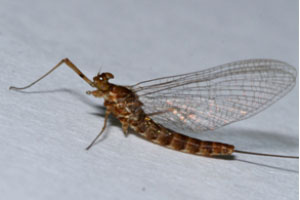The quill gordon is reportedly named for Theodore Gordon who copies its form when designing his famous quill gordon trout fishing fly.
Photo Credit: Donald S. Chandler
Epeorus pleuralis
Common Name: quill gordon
Other Common Names: blue quill, dark gordon quill, gordon quill, iron dun, red quill spinner
Other Scientific Names: Epeorus confusus, Epeorus fradulator, Heptagenia pleuralis, Iron confusus, Iron fraudator, Iron pleuralis
Animal Guild: Insect
Class > Order > Family: Insecta > Ephemeroptera > Heptageniidae
